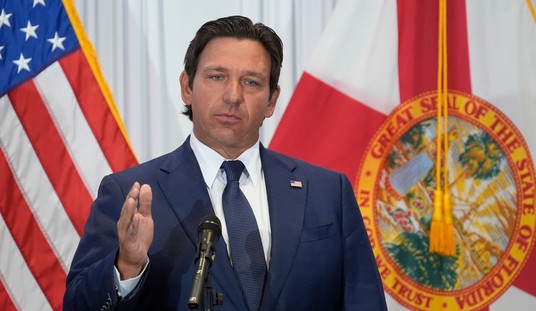It would be nice if the future of federalism did not rest on what Anthony Kennedy had for breakfast –- if Senate Republican Leader Mitch McConnell did not spend all of December, 2009, giving Harry Reid back-to-back votes on issues which allowed Reid to buy off swing senators.
But we are where we are. So…
THE OBAMA ADMINISTRATION HAS ONE ARGUMENT STANDING ON BEHALF OF THE CONSTITUTIONALITY OF OBAMACARE: 116 BILLION.
That is the amount of cost-shifting Obama now claims occurs as a result of treating uninsured individuals.
Four problems:
First, 116 billion is nothing but a politicized magnification of the amount (43 billion) which the insurance companies claimed in cost-shifting from the uninsured to policy-holders during their ObamaCare lobbying campaign. (The 43 billion figure is where the $1,000-per-policy cost-shifting figure comes from.) But both the 116 billion and the 43 billion figures are fraudulent numbers which interested parties simply pulled out of the air.
Second, the administration understands the inherent bias in insurance company numbers when it suits its purposes. When Price-Waterhouse, in the eve of the passage of ObamaCare, estimated that it would increase the price of family policies to almost $25,000 a year by 2019, the Obama administration mercilessly attacked the number. 116 billion -– or 43 billion -– or $1,000 per policy — is no different. In their hearts, the administration understands it is lying to the court.
Third, whatever cost-shifting problems there are, over 68% of them are due, not the “young invincibles,” who are nothing but, once again, hapless “cash cows” who are being bled to fund a system which transfers their assets to those who, in some cases because of their own choices, are less healthy than they are. Rather, current cost-shifting problems, to the extent they exist, are as a result of the poor. But here’s the problem: Under ObamaCare, the poor (anyone with an income under 133% of the poverty level) would be put on Medicaid — AND TURNED FROM DE FACTO “FREE RIDERS” INTO STATUTORILY MANDATED “FREE RIDERS.”
Which leads to: Fourth, everyone understands that the reason for the mandate was not to address the “free rider” problem (which could have much more easily been done by modifying the 1986 treatment mandate in minor ways), but rather to bribe the insurance companies into not running Harry & Louise ads.
NOW FOR A LITTLE LEGAL REALISM
The justices are only human.
And conservatives have fallen down in failing to make a bigger issue over liberal attempts to threaten and intimidate the court -– first, in the New York Times, then in the Washington Post [“Will Conservatives save Obamacare?” by Robert Barnes, the Washington Post, March 18, 2012, page B1] -– and repeatedly by Bob Beckel and others on Fox.
All of the threats are thinly veiled (“Roberts is protective of the court’s reputation, however, and sensitive to the perception that its decisions are politicized.”), but they are nothing more or less than disguised threats to attack the court if it doesn’t do as liberals want.
Interestingly, speaking of politicized justice, both the New York Times and the Washington Post, in their court “vote-counting,” start with the proposition that the four liberals on the court will “jump” when told to by the Obama administration. This is hardly a ringing endorsement of the independence or the judicial integrity of Ginsburg, Breyer, Sotomayor, and Kagan.
True, Kennedy has shown, in Massachusetts v. EPA, that he is not oblivious to a firestorm of public opinion swirling around him. But, with Gallup showing that between 72% and 76% of the public believes ObamaCare is unconstitutional, and with other polls showing that 67% of Americans believe that either ObamaCare or the mandate is unconstitutional, liberals are making a threat which they can’t enforce.
And, lest anyone believe that liberals believe their vote-counting bravado, Friday, two Columbia Law professors [Abbe Gluck and Michael Graetz] published an op-ed in the New York Times arguing that, should the mandate be overturned by the court, the statute should nevertheless be severed. (More on this later, but what does that tell you about their assessment of the likelihood of success?)
They understand, as do most court-watchers, that there are legal realities which are never vocalized, but are true nonetheless:
WICKARD V. FILBURN DOESN’T REALLY GIVE YOU ANY CLUE ABOUT WHAT THE COURT WILL DO: This is the 1942 case where a farmer was penalized for growing wheat for his own consumption because, were everyone to do the same, it would impact commerce.
This is taught in law schools as a “can-you-believe-that?” case. It was the high water mark of politicized New Deal jurisprudence, and is now generally viewed by conservatives as the epitome of what was wrong with the Roosevelt court. And it would have to be extended even further to apply to someone who didn’t even grow wheat -– and, in fact, did nothing.
GONZALES V. RAICH DOESN’T REALLY GIVE YOU ANY CLUE ABOUT WHAT THE COURT WILL DO: This was the case about whether the federal government could preempt state laws on medical marijuana.
If you look at the way the court deals with “law-and-order” cases, it differs from its approach to other appeals. There was no way the court was going to, effectively, legalize all drugs in order to overturn Wickard. And the fact that it considered doing that tells you something.
THE FACT THAT THE COURT, IN THREE POLITICALLY DIFFICULT CASES, FAILED TO FIND A COMMERCE CLAUSE JUSTIFICATION FOR GUN-FREE SCHOOL ZONES, PARTS OF THE VIOLENCE AGAINST WOMEN ACT, AND PARTS OF THE BRADY LAW DOES TELL YOU SOMETHING ABOUT THE COURT’S -– AND KENNEDY’S -– PREDISPOSITION ON ARTICLE I, SECTION 8, ISSUES.
THREE OBSERVATIONS ON SEVERABILITY
THE FACT THAT THE COURT SET ASIDE AN HOUR TO ARGUE SEVERABILITY, WHILE NOT DISPOSITIVE, IS MORE SIGNIFICANT THAN LIBERALS WOULD LIKE TO BELIEVE.
NOTWITHSTANDING EVERYTHING, I WOULD BET THE COURT WOULD REMAND THE CASE FOR AT LEAST SOME OF THE SEVERABILITY DELIBERATIONS.
WANT TO KNOW WHY THE SEVERABILITY CLAUSE IN EARLIER DRAFTS “MYSTERIOUSLY” DISAPPEARED? I have gone round-and-around with both House and Senate Legislative Counsel over this issue. And one or the other will regularly remove severability language from a draft because, while not irrelevant, it is not dispositive. It is a way that the Leg Counsel’s office asserts its authority against congressmen who “dare” to draft their own legislation.
Of course, as the mandate became more controversial at the end of the process, senators did begin to notice that the severability clause had disappeared.
Had Jim DeMint not objected to waiving the nine-day process necessary to send a bill to conference, the severability clause could have been easily reinserted in conference. But he did; and it wasn’t.
Finally, there was the opportunity to reopen the bill to further amendments, including an amendment on the severability clause, to assuage Democratic moderates like Ben Nelson, after the manager’s amendment had been presented. But, again, this would have required chopping apart the “tree” constructed to block DeMint, and that would have kept the Senate in session until well past Christmas. So that wasn’t done either.
But the point for the court to consider is that senators knew they had an opportunity to reinsert the severability clause, but with considerable pain, and chose not to.
by Michael E. Hammond, former General Counsel Senate Steering Committee 1978-89 and a Dunbarton, New Hampshire resident.













Join the conversation as a VIP Member